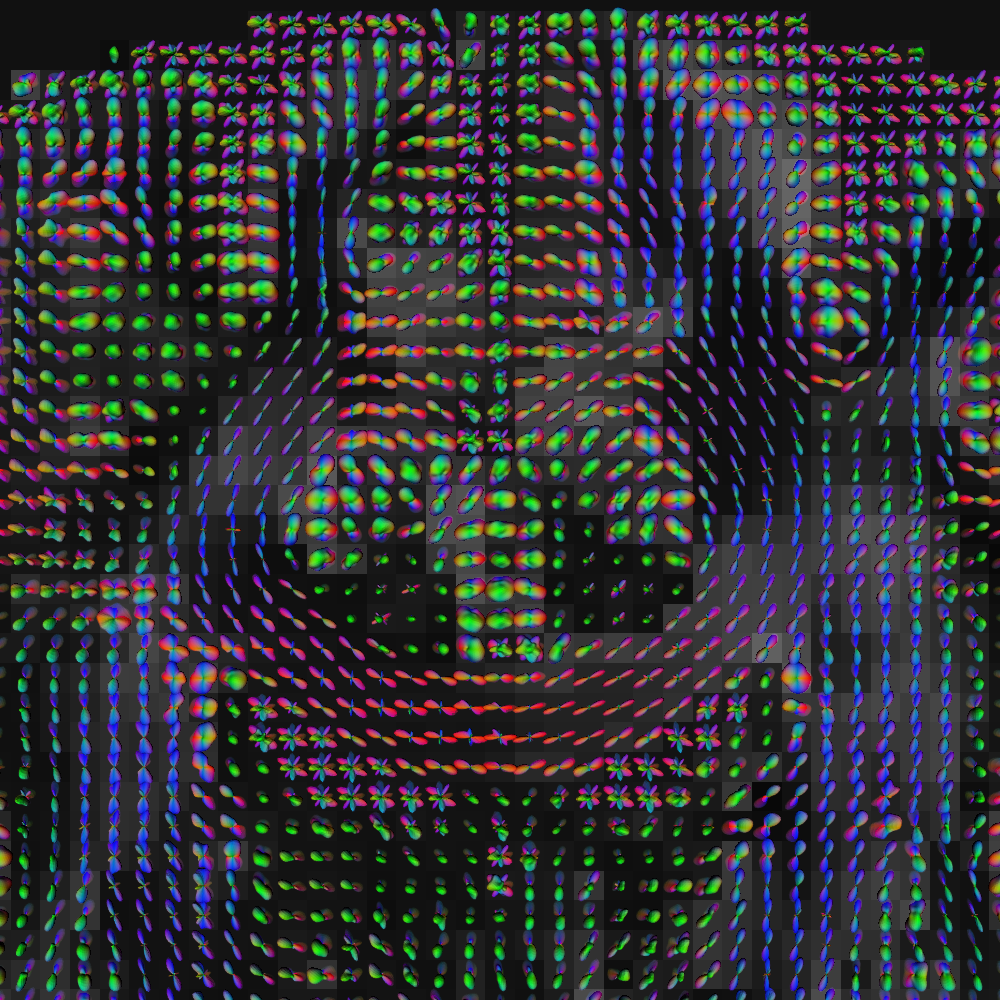Note
Go to the end to download the full example code
Local reconstruction using the Histological ResDNN#
A data-driven approach to modeling the non-linear mapping between observed DW-MRI signals and ground truth structures using sequential deep neural network regression with residual block deep neural network (ResDNN) [1], [2].
Training was performed on two 3-D histology datasets of squirrel monkey brains and validated on a third. A second validation was performed on HCP datasets.
import os
import numpy as np
import scipy.ndimage as ndi
from dipy.core.gradients import gradient_table
from dipy.data import get_fnames, get_sphere
from dipy.io.gradients import read_bvals_bvecs
from dipy.io.image import load_nifti, save_nifti
from dipy.nn.histo_resdnn import HistoResDNN
from dipy.reconst.shm import sh_to_sf_matrix
from dipy.segment.mask import median_otsu
from dipy.viz import actor, window
# Disable oneDNN warning
os.environ["TF_CPP_MIN_LOG_LEVEL"] = "2"
This ResDNN model requires single-shell data with one or more b0s, the data is fetched and a gradient table is constructed from bvals/bvecs.
# Fetch DWI and GTAB
hardi_fname, hardi_bval_fname, hardi_bvec_fname = get_fnames(name="stanford_hardi")
data, affine = load_nifti(hardi_fname)
data = np.squeeze(data)
bvals, bvecs = read_bvals_bvecs(hardi_bval_fname, hardi_bvec_fname)
gtab = gradient_table(bvals, bvecs=bvecs)
To accelerate computation, a brain mask must be computed. The resulting mask is saved for visual inspection.
mean_b0 = data[..., gtab.b0s_mask]
mean_b0 = np.mean(mean_b0, axis=-1)
_, mask = median_otsu(mean_b0)
mask_labeled, _ = ndi.label(mask)
unique, count = np.unique(mask_labeled, return_counts=True)
val = unique[np.argmax(count[1:]) + 1]
mask[mask_labeled != val] = 0
save_nifti("mask.nii.gz", mask.astype(np.uint8), affine)
Using a ResDNN for sh_order_max 8 (default) and load the appropriate weights. Fit the data and save the resulting fODF.
resdnn_model = HistoResDNN(verbose=True)
resdnn_model.fetch_default_weights()
predicted_sh = resdnn_model.predict(data, gtab, mask=mask)
save_nifti("predicted_sh.nii.gz", predicted_sh, affine)
Preparing the scene using FURY. The ODF slicer and the background image are added as actors and a mid-coronal slice is selected.
interactive = False
sphere = get_sphere(name="repulsion724")
B, invB = sh_to_sf_matrix(
sphere, sh_order_max=8, basis_type=resdnn_model.basis_type, smooth=0.0006
)
fod_spheres = actor.odf_slicer(
predicted_sh, sphere=sphere, scale=0.6, norm=True, mask=mask, B_matrix=B
)
mean_sh = np.mean(predicted_sh, axis=-1)
background_img = actor.slicer(mean_sh, opacity=0.5, interpolation="nearest")
# Select the mid coronal slice for slicer
ori_shape = mask.shape[0:3]
slice_index = ori_shape[1] // 2
fod_spheres.display_extent(0, ori_shape[0], slice_index, slice_index, 0, ori_shape[2])
background_img.display_extent(
0, ori_shape[0], slice_index, slice_index, 0, ori_shape[2]
)
scene = window.Scene()
scene.add(fod_spheres)
scene.add(background_img)
Adjusting the camera for a nice zoom-in of the corpus callosum (coronal) to screenshot the resulting prediction. FODF should be aligned with the curvature of the corpus callosum and a single-fiber population should be visible.
camera = {
"zoom_factor": 0.85,
"view_position": np.array(
[(ori_shape[0] - 1) / 2.0, max(ori_shape), (ori_shape[2] - 1) / 1.5]
),
"view_center": np.array(
[(ori_shape[0] - 1) / 2.0, slice_index, (ori_shape[2] - 1) / 1.5]
),
"up_vector": np.array([0.0, 0.0, 1.0]),
}
scene.set_camera(
position=camera["view_position"],
focal_point=camera["view_center"],
view_up=camera["up_vector"],
)
scene.zoom(camera["zoom_factor"])
if interactive:
window.show(scene, reset_camera=False)
window.record(
scene=scene, out_path="pred_fODF.png", size=(1000, 1000), reset_camera=False
)

Visualization of the predicted fODF.
References#
Total running time of the script: (0 minutes 29.693 seconds)